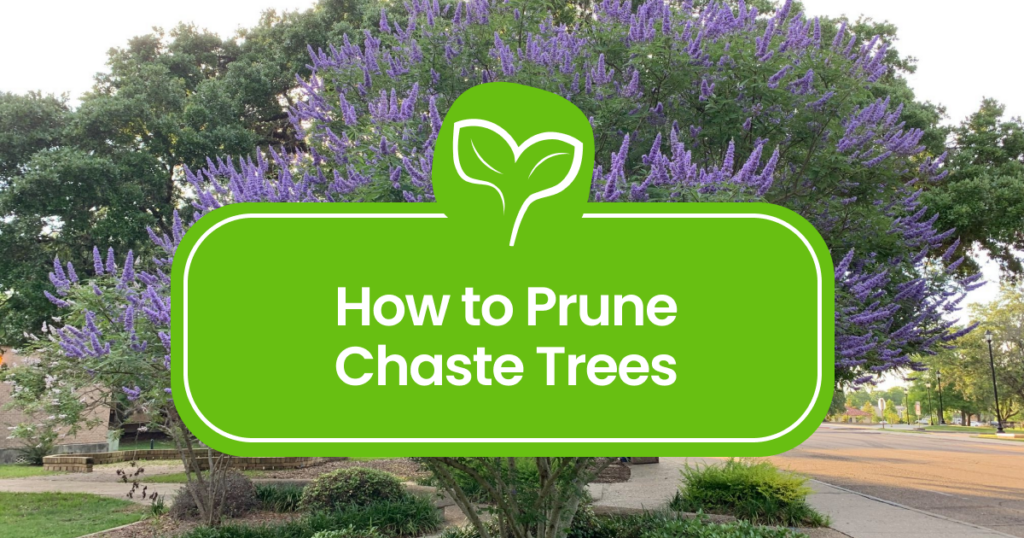
Welcome to the comprehensive guide on Chaste Tree Pruning! With the right guidance and knowing the basics, pruning becomes a simple and rewarding way to care for these beautiful trees, also known as Vitex Trees. In this step-by-step walkthrough, we’ll delve into the art of pruning Chaste Trees, discussing the why, when, and how of this essential practice.
Whether you’re aiming to shape your tree for a picturesque garden or seeking to promote its health and vibrant blooms, this guide is your go-to resource. Let’s dive into the world of Chaste Tree pruning, empowering you to nurture your tree and watch it thrive.
Why Prune Chaste Trees?
Pruning chaste trees isn’t mandatory, but it’s incredibly beneficial. It offers control over the tree’s size and shape, promoting repeat flowering through a technique known as deadheading. Also, addressing damaged, sick or dead branches ensures the tree stays healthy and vibrant. So it is not an absolute must if you have a Chaste Tree, but pruning can enhance the tree’s aesthetics and overall well-being.
When to Prune Chaste/Vitex Trees?
Timing matters. For the best outcomes, tackle major pruning of your chaste trees in late winter, before they start sprouting new growth. When you’re trimming branches, aim for your preferred length or where one branch meets another. If you’re just shortening a branch, cut it right above a little bud or twig. This timing works well with how the tree grows, giving it enough time to bounce back and making sure pruning helps your tree flourish.
The Tools You’ll Need
Let’s keep it simple! You need to grab your pruning shears, loppers (for thicker branches), and a pruning saw, plus you might need a ladder to reach higher. Also, don’t forget gloves since they’re essential for protecting your hands.

Chaste Tree Pruning Step-by-Step
- Clean Your Tools: Before diving into pruning, ensure your tools are clean and sharp. A quick wipe-down with rubbing alcohol and sharpening the blades makes for precise cuts and reduces the risk of spreading diseases.
- Assess and Remove Damaged Branches: Start by identifying and removing damaged or dead branches. Trim these beyond the point of breakage or the dead part to maintain tree health.
- Size and Shape Control: For size management, cut branches to desired lengths or where they intersect other branches, focusing on areas where light needs to penetrate.
- Tree Transformation: To shape your chaste tree into a tree-like form, begin by removing lower limbs and branches in late winter before new growth emerges. Aim to maintain a balanced canopy while creating clearance underneath.
- Deadheading for Repeat Blooms: After the initial bloom cycle, deadhead spent flower stems to encourage another round of blossoms. Snip these off at the base using bypass pruners.
Aftercare
After pruning your chaste tree, show it some post-trim love for optimal regrowth. Spread a layer of mulch around the base to retain moisture and keep pesky weeds at bay. Keep up with regular watering to support the tree’s recovery, and keep an eye out for any signs of stress or disease to address them pronto.

Frequently Asked Questions
When is the best time to prune a chaste tree?
The best time to prune a chaste tree is in late winter, before new growth emerges, allowing the tree ample time to recover. This timing, pre-new growth, ensures minimal disturbance to the tree’s natural growth cycle and encourages healthy regrowth after pruning.
Should I deadhead my vitex?
Yes, deadheading your vitex can encourage a second round of blooms after the initial flowering. Trimming back the old flowers or seed pods just behind the faded cluster or flower spike can prompt your vitex tree to produce another burst of beautiful blossoms.
How often should I prune my chaste tree?
Chaste trees don’t need a whole lot of pruning, but giving them an annual trim each winter is a smart move.
How much should I trim back my chaste tree?
Chaste trees often grow like shrubs, but pruning can transform them into tree-like forms. Remove lower suckers, small branches, and any crossing or damaged ones, aiming to create space and allow more light to reach the main branches for a healthier and more tree-like appearance.

